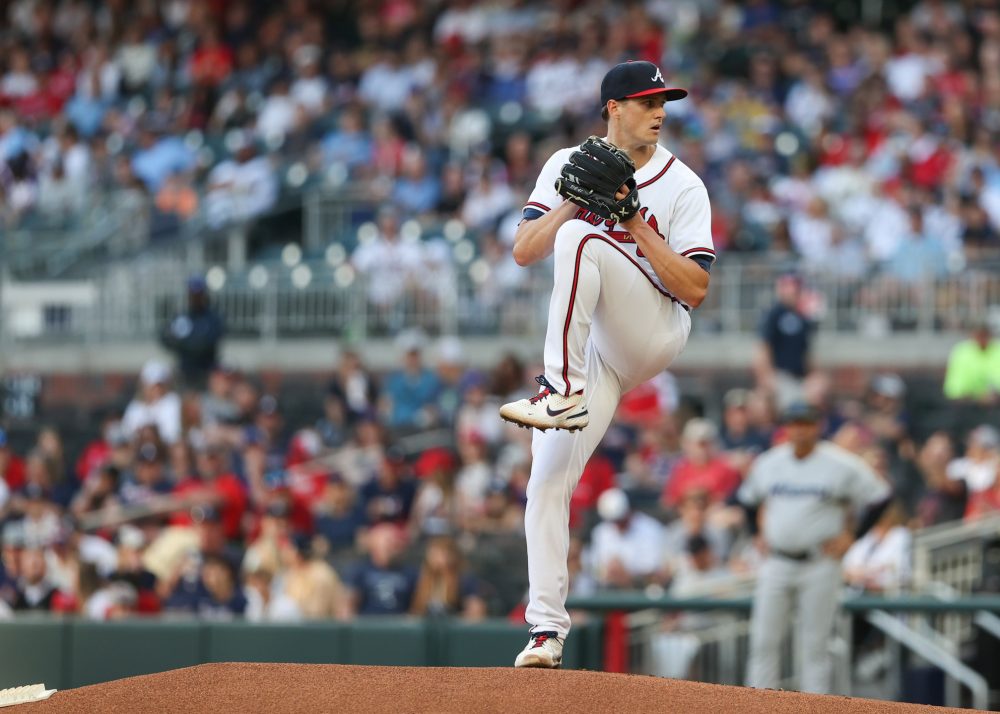
Kyle Wright has had nothing but expectations. From Vanderbilt ace to fifth-overall draft pick to top prospect multiple times over, Wright was destined to take the reins of a rotation spot in Atlanta for years to come. After parts of four major league seasons, that had yet to materialize, despite Wright’s quick ascension through the minors. Coming into 2022, Wright owned a rough 6.56 ERA for his career. Additionally, his strikeout and walk rates—or any peripheral metrics for that matter—didn’t signal better times were ahead.
But things have changed rather drastically this year. In four starts, Wright has pitched to a squeaky clean 1.13 ERA. He’s more than doubled his career strikeout rate, and his current mark of 37% is now seventh-best among all starting pitchers. At least on the surface, Wright seems to be a different pitcher, and his progress has been well documented so far.
For pitchers, major swings in career trajectories can be attributed to any one of an infinite combination of factors. Sometimes they find fastball velocity; other times they learn where to better attack the zone, or alter their release point, or design (or redesign) a new pitch. In rare cases, they just figure it all out. In ever-rarer cases, all of these things happen at once. Wright falls into that final camp. Put another way, Wright doesn’t just seem like a new pitcher, he is a new pitcher.
First, let’s talk about fastball velocity.
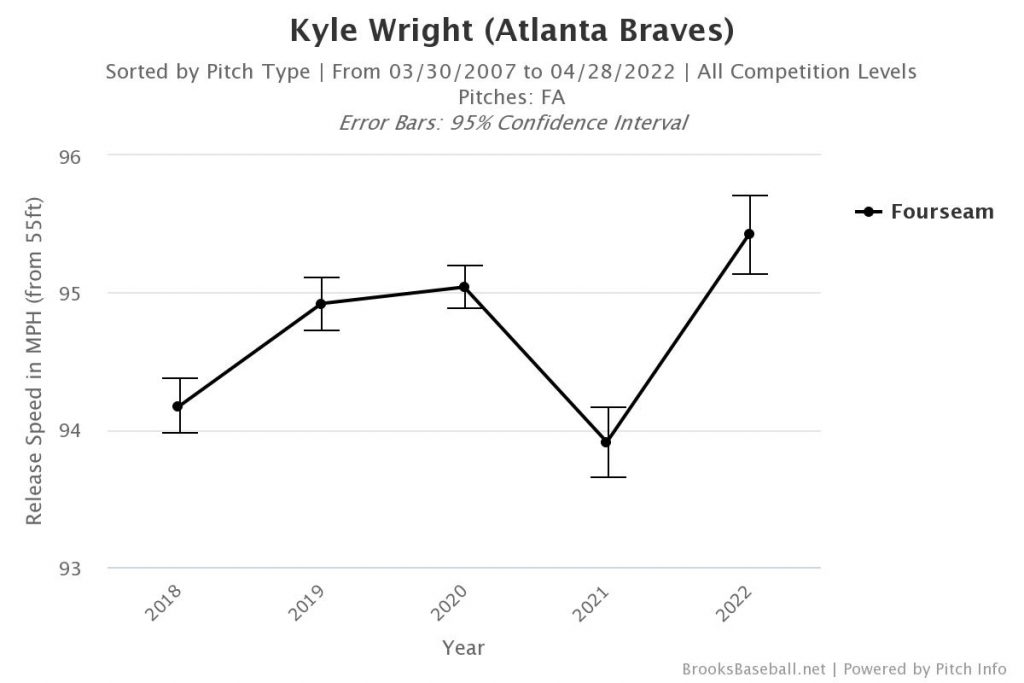
Generally, Wright has thrown his fastball with above-average velocity, but this year in particular, he’s really bringing it in the early going, increasing from just south of 94 mph to nearly 95.5 mph. This has been a bat-missing boon for Wright, who has struggled to get swings and misses in general, let alone on the fastball. So far in 2022, he’s gotten whiffs on 31.58% of total swings, a mark that sits sixth-best among starters, right behind Hunter Greene.

While a fastball velocity increase alone can be the sole cause of a spike of swings and misses, that’s not the case for Wright. Before 2022, his inability to miss bats with his four-seamer was also partially due to a bad fastball shape, as well as a suboptimal release point for said fastball shape. For a closer look, consider the following two videos of four-seamers thrown by Wright, the first from 2020:
And this one from 2022:
Quick note: I chose a pitch from 2020 to compare instead of 2021 because Wright made only two appearances last year, and neither of them were at home with Atlanta’s wonderful dead center camera which makes it easier to do these types of analyses.
Just like I’ve done before, let me take you on a frame by frame journey, starting with positioning on the rubber.
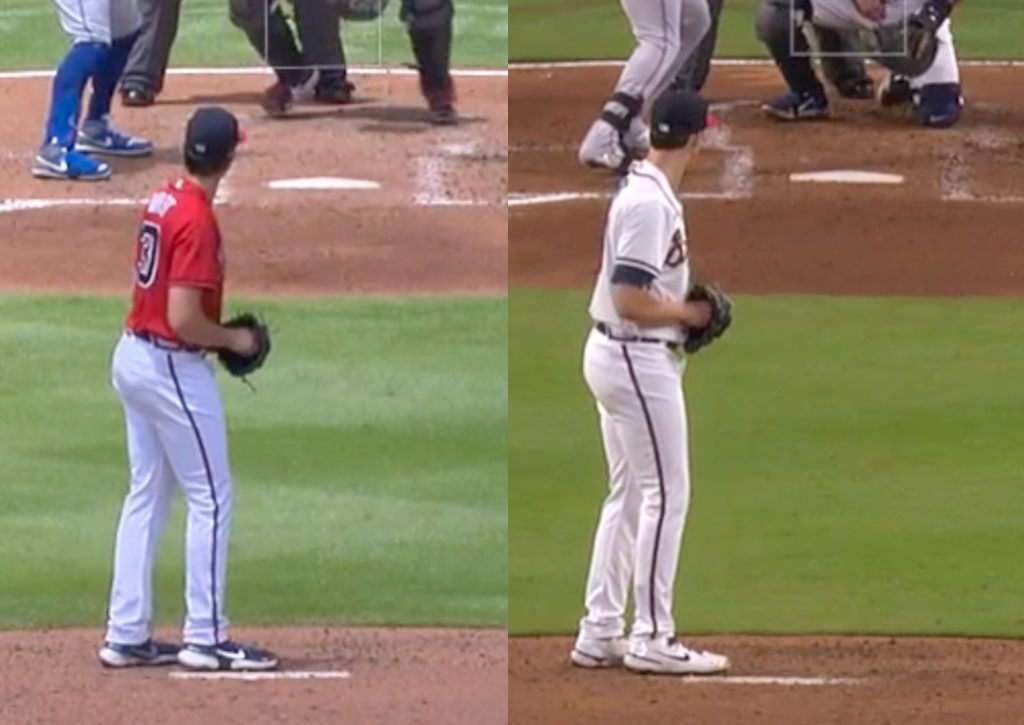
We see that while he was already to the first base side of the rubber in 2020, he is much more extreme here in 2022. To be fair, he did make this adjustment last year, but all of the following adjustments are new to this year. Some other adjustments we see include his shoulder and head positioning, which will become important a little later on. Let’s next move to his leg lift, where we start to see more clear changes.

Here we can see the influence of his preset shoulder positioning. With straight lines drawn from the middle of his head to the pitching rubber, it is evident that Wright is in a more athletic posture than before, with his head more over his toes than over his heels. This will greatly impact how he looks as he drives.
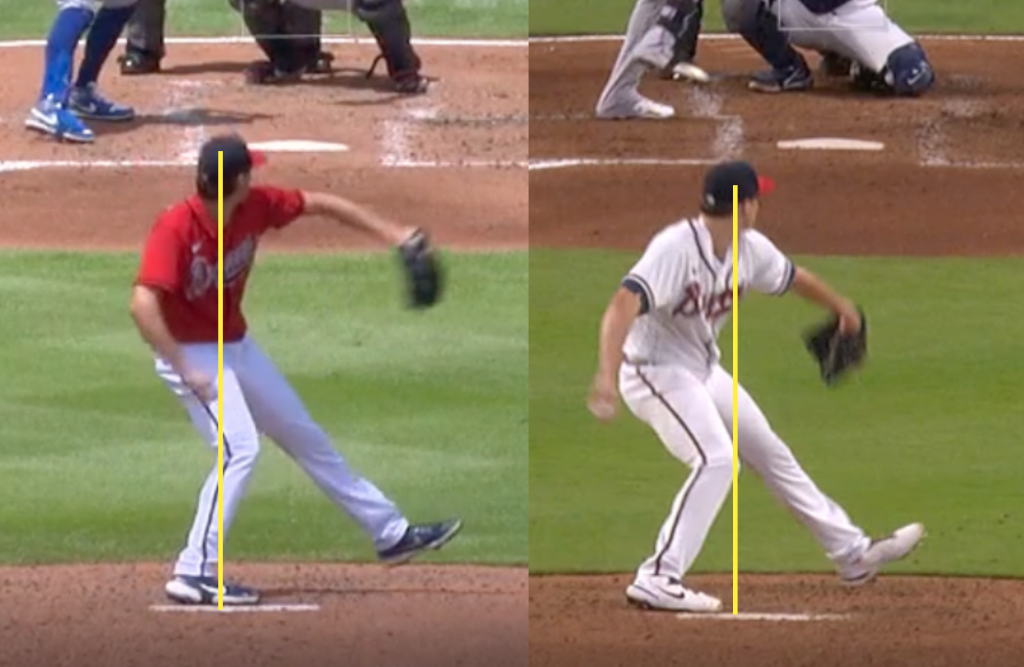
As Wright extends his front leg and drives down the mound, the differences become stark. His head is lower, which indicates an increased stride length (and possibly better extension), and his shoulders tell us multiple stories. With the same lines drawn from before, we see that his head is now well out in front of his back foot. Additionally, his shoulders are more parallel to the ground as opposed to tilted backward.
It is also evident that, although this is harder to see from this angle, that his weight is more centered. His delivery from 2020 is more ‘reach back and fire’ while his 2022 delivery is more ‘drop and drive.’ Next, let’s take a look at his front foot strike.
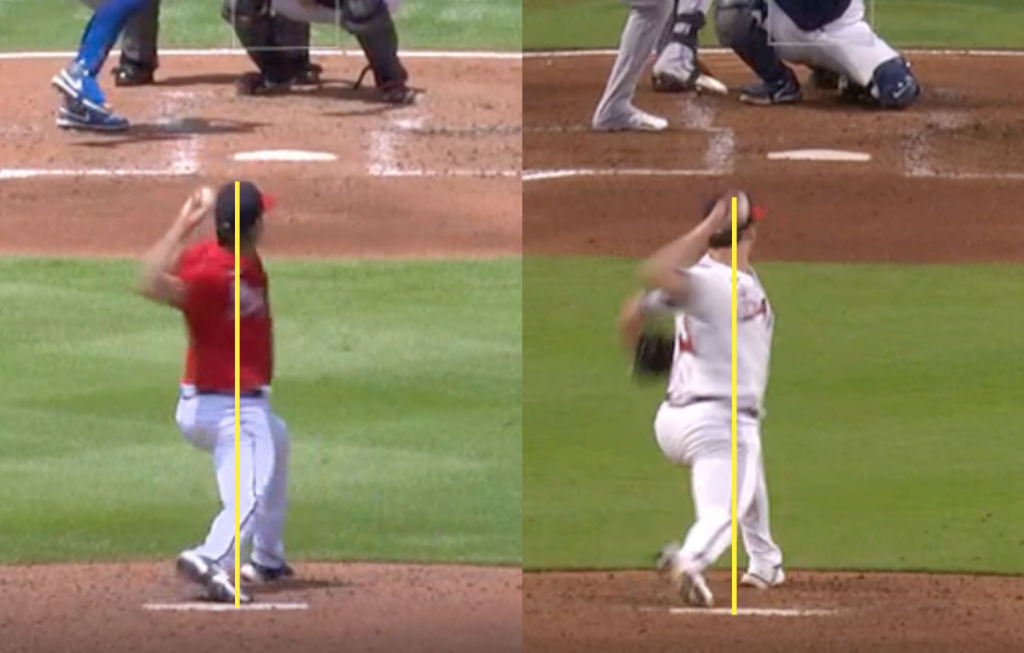
The trend continues with Wright’s shoulder positioning, and now we get to see the results. Wright is throwing a little more across his body, which means more rotational energy, which means more velocity. Moreover, notice how in 2022, we can see both of his elbows. This is known as ‘scap loading,’ and Wright is doing it much better this year.
Scap loading allows the trunk to lead, giving the arm more time to transfer energy from a pitcher’s body to the ball. Wright is able to do this thanks to the better action he is getting with his back leg pointed out in the previous still. This leads us to the grand finale and the star piece of Wright’s newfound success—his new, lower release point.

If you’ve read any of the content that is already out there about Wright and his improvement this year, this has been a big call out, and rightfully so! But pitchers rarely just change their arm angle and call it a day. Pitchers greatly rely on repetition and muscle memory to master their mechanics. Since release point is the last thing that happens in a pitcher’s delivery, there are likely other changes that helped them get there.
With all of that said, Wright already had a low release point, meaning that his fastball would play up in the zone with a flat vertical approach angle, but he has leaned into this in 2022, and combined with his aforementioned increased velocity, and better spin efficiency (giving it a better shape), he has taken it to the next level, giving him a very interesting comp. Further, my hypothesis on his getting better extension proves to be correct.
| Pitcher (Year) | Velocity | Release Height | Extension | Plate Height* | Active Spin | VMov | HMov | VAA | Whiff Rate |
| Wright (2021) | 93.91 | 5.79 | 6.3 | 0.27 | 74 | 6.62 | -4.65 | -4.5 | 14.71 |
| Wright (2022) | 95.39 | 5.52 | 6.7 | 0.98 | 85 | 6.83 | -7.27 | -3.9 | 31.58 |
| Joe Ryan (2022) | 92.52 | 5.05 | 6.3 | 0.49 | 96 | 7.77 | -6.33 | -3.9 | 30.28 |
*measured as vertical distance from the center of the zone
There are some clear differences between Ryan and Wright’s fastballs, namely velocity and spin efficiency. Ryan has one of the lowest release points among starting pitchers in baseball, but Wright’s isn’t too far off, and by VAA, they grade out exactly the same. Wright does need to attack the zone higher to get his results, and he’s been doing exactly that, averaging nearly a foot above the middle of the zone with the pitch. Ryan’s fastball is a good one to emulate if a pitcher can pull it off, since we know that its extremely flat VAA is what makes it special.
Now that we have the four-seam fastball out of the way, let’s also talk about the by-products of this, as his new release point has affected not just his fastball pitch shapes, but the shapes of his entire arsenal.
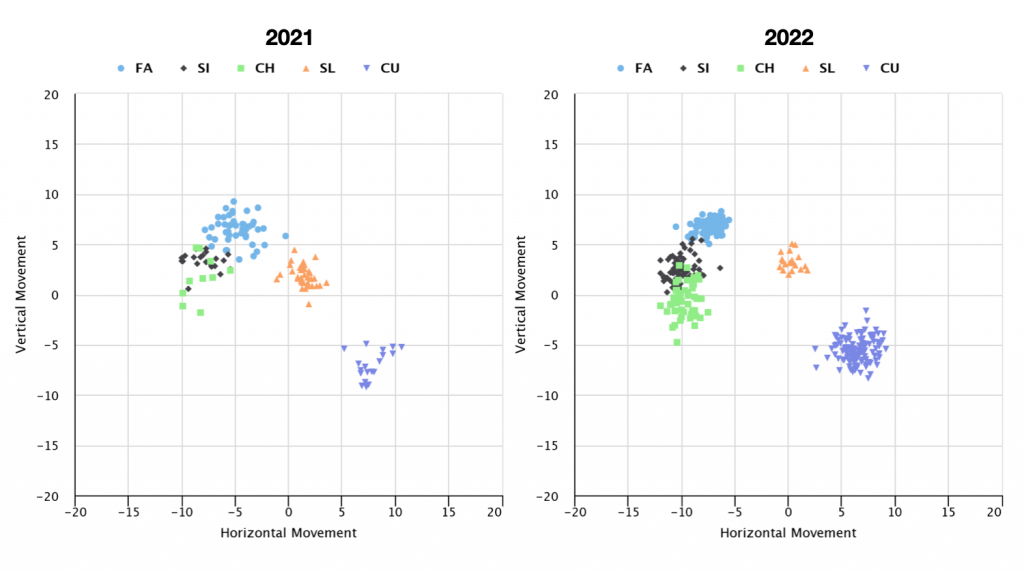
From these plots, we see a few things. One, much more arm-side movement and sink on his sinker, thanks to the added spin efficiency. While I did note that Wright greatly improved the spin efficiency of his four-seamer, 85% isn’t generally considered great. That’s actually okay, though, because he is now in the sweet spot for a sinker. Combined with the lower arm angle and the change in spin direction that goes along with that, Wright is now maximizing seam-shifted wake effects, resulting in a much better pitch with two more inches of run and an extra inch of sink than a year ago.
According to BP’s PitchInfo leaderboard, Wright’s sinker has the ninth-most run and sink. The pitch has netted not only a -18-degree launch angle, but he’s also not afraid to go to it for a swing and miss, even with two strike counts.
Next, we see a big shift with his changeup, which has much more drop and a more distinct shape from his sinker. This pitch hasn’t had much presence in Wright’s career as a big-leaguer until this season, when it’s become incredibly effective against both righties and lefties, as it has the highest rate of whiffs per swing of all his pitches. Again, thanks to the lower release point, the pitch drops slightly faster than the rate of gravity, proving once again that he is maximizing SSW effects. Once again using the PitchInfo leaderboard, he’s getting the fifth-most drop on changeups among starting pitchers.
Wright’s SSW maximizing has helped him not only increase swings and misses, but also get swings outside of the zone, as the above video shows. To date, Wright’s chase percentage mark of 38.6 is a career best, and ranks 17th among pitchers who have thrown at least 10 innings this season. When he gets hitters to expand the zone? A microscopic .069 wxOBA is the result, once again one of the best marks among starters in baseball.
Finally, we see a few trends in his breaking balls. By both movement and velocity, they’re both more firm, and we also see that he has transitioned to leaning on his curveball more than his slider, going to Uncle Charlie over 33% of the time, the highest rate of his career to date.

Speaking of people named Charlie, I have a working theory here: With all of these mechanical adjustments and new pitch shapes, I noticed something else when doing research on this piece. This new version of Wright, with his lower arm angle and heavy fastball-curveball approach, looks a lot like rotation mate and seasoned veteran Charlie Morton. When we compare the pitch data, the similarities become hard to ignore.
| Pitcher (Pitch Type) | Spin Rate | Active Spin | Spin Direction | Movement Direction | Deviation |
| Wright (FF) | 2411 | 85 | 1:45 | 1:30 | 15 |
| Morton (FF) | 2391 | 85 | 1:30 | 1:15 | 15 |
| Wright (CU) | 2676 | 65 | 7:45 | 7:30 | 15 |
| Morton (CU) | 2999 | 72 | 7:45 | 7:45 | 0 |
| Wright (SI) | 2253 | 85 | 1:45 | 2:30 | -45 |
| Morton (SI) | 2226 | 91 | 1:45 | 2:30 | -45 |
Looking at a side by side video of their respective curveballs thrown to a similar location, it becomes even harder to ignore. Focus both on the deliveries as well as the pitches themselves.
Many if not all of the changes I documented in Wright’s delivery line up with Morton’s, and I have already noted the similarities in pitch shapes. I’m only speculating that this was a calculated move for Wright to emulate Morton, but we do know that Morton’s career took off when he decided to emulate Roy Halladay’s delivery, so it isn’t completely outside the realm of possibility. Just for good measure, here are their fastball release points side by side as well.

Whatever the case may be, whether Wright is emulating anyone or if these things are complete coincidence, what we can say for certain is that his results are his, and he is doing this based on his skill and his skill alone. Thanks to the right adjustments, Wright is living up to his potential as a front-end to mid-rotation starter.
As always with small samples to start the season, there is room for regression. Wright is stranding a ton of runners and has yet to give up a home run, but if his whiff, chase, and quality of contact rates remain sticky, he should continue this run of great pitching, even if he doesn’t continue to be this great.
Thank you for reading
This is a free article. If you enjoyed it, consider subscribing to Baseball Prospectus. Subscriptions support ongoing public baseball research and analysis in an increasingly proprietary environment.
Subscribe now